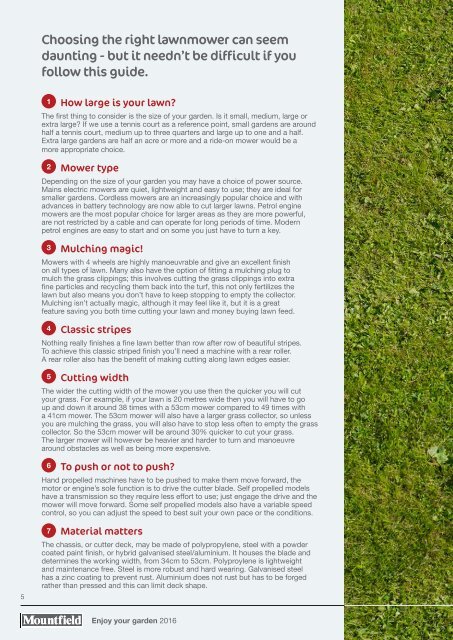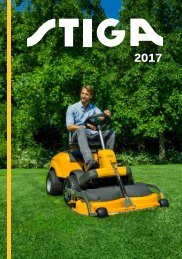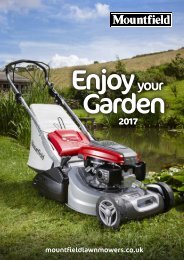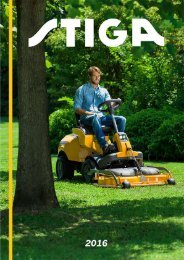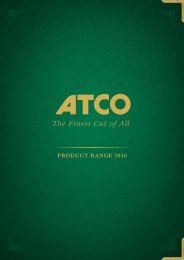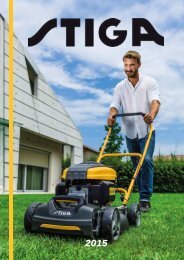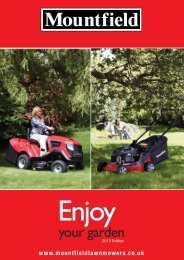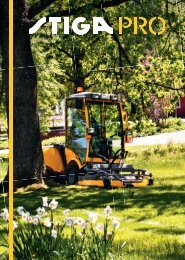You also want an ePaper? Increase the reach of your titles
YUMPU automatically turns print PDFs into web optimized ePapers that Google loves.
Choosing the right lawnmower can seem<br />
daunting - but it needn’t be difficult if you<br />
follow this guide.<br />
1 How large is your lawn?<br />
The first thing to consider is the size of your garden. Is it small, medium, large or<br />
extra large? If we use a tennis court as a reference point, small gardens are around<br />
half a tennis court, medium up to three quarters and large up to one and a half.<br />
Extra large gardens are half an acre or more and a ride-on mower would be a<br />
more appropriate choice.<br />
2 Mower type<br />
Depending on the size of your garden you may have a choice of power source.<br />
Mains electric mowers are quiet, lightweight and easy to use; they are ideal for<br />
smaller gardens. Cordless mowers are an increasingly popular choice and with<br />
advances in battery technology are now able to cut larger lawns. Petrol engine<br />
mowers are the most popular choice for larger areas as they are more powerful,<br />
are not restricted by a cable and can operate for long periods of time. Modern<br />
petrol engines are easy to start and on some you just have to turn a key.<br />
3 Mulching magic!<br />
Mowers with 4 wheels are highly manoeuvrable and give an excellent finish<br />
on all types of lawn. Many also have the option of fitting a mulching plug to<br />
mulch the grass clippings; this involves cutting the grass clippings into extra<br />
fine particles and recycling them back into the turf, this not only fertilizes the<br />
lawn but also means you don’t have to keep stopping to empty the collector.<br />
Mulching isn’t actually magic, although it may feel like it, but it is a great<br />
feature saving you both time cutting your lawn and money buying lawn feed.<br />
4 Classic stripes<br />
Nothing really finishes a fine lawn better than row after row of beautiful stripes.<br />
To achieve this classic striped finish you’ll need a machine with a rear roller.<br />
A rear roller also has the benefit of making cutting along lawn edges easier.<br />
5 Cutting width<br />
The wider the cutting width of the mower you use then the quicker you will cut<br />
your grass. For example, if your lawn is 20 metres wide then you will have to go<br />
up and down it around 38 times with a 53cm mower compared to 49 times with<br />
a 41cm mower. The 53cm mower will also have a larger grass collector, so unless<br />
you are mulching the grass, you will also have to stop less often to empty the grass<br />
collector. So the 53cm mower will be around 30% quicker to cut your grass.<br />
The larger mower will however be heavier and harder to turn and manoeuvre<br />
around obstacles as well as being more expensive.<br />
6 To push or not to push?<br />
Hand propelled machines have to be pushed to make them move forward, the<br />
motor or engine’s sole function is to drive the cutter blade. Self propelled models<br />
have a transmission so they require less effort to use; just engage the drive and the<br />
mower will move forward. Some self propelled models also have a variable speed<br />
control, so you can adjust the speed to best suit your own pace or the conditions.<br />
5<br />
7 Material matters<br />
The chassis, or cutter deck, may be made of polypropylene, steel with a powder<br />
coated paint finish, or hybrid galvanised steel/aluminium. It houses the blade and<br />
determines the working width, from 34cm to 53cm. Polyproylene is lightweight<br />
and maintenance free. Steel is more robust and hard wearing. Galvanised steel<br />
has a zinc coating to prevent rust. Aluminium does not rust but has to be forged<br />
rather than pressed and this can limit deck shape.<br />
Enjoy your garden <strong>2016</strong>


